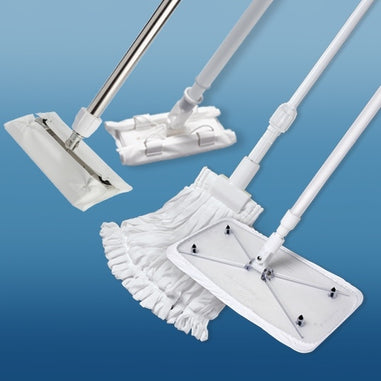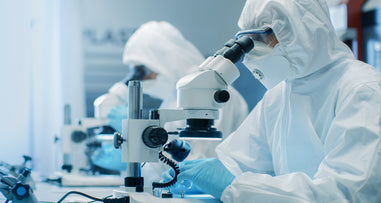- No products in the cart.
Cleanrooms are critical environments where maintaining cleanliness and sterility is essential to prevent contamination, protect sensitive processes, and ensure the quality of the products being produced. Whether in pharmaceutical manufacturing, biotechnology, microelectronics, or any other industry requiring stringent environmental controls, the cleanliness of surfaces in a cleanroom is paramount. A key tool in achieving and maintaining these standards is the cleanroom mop.
In this blog, we'll explore the right way to clean cleanroom surfaces using a cleanroom mop, specifically focusing on high-quality mops from Texwipe and Berkshire, two leading brands in the cleanroom industry. Additionally, we'll include a chart detailing cleanroom classifications, providing context on the different levels of cleanliness required in various settings.
Understanding Cleanroom Classifications
Before diving into the mopping techniques, it's crucial to understand cleanroom classifications. Cleanrooms are classified according to the number and size of particles permitted per volume of air. The most widely used standards are those from the International Organization for Standardization (ISO), with ISO Class 1 being the cleanest and ISO Class 9 being the least stringent.
Here's a chart that provides a summary of the cleanroom classifications:
| ISO Class | Maximum Particles per Cubic Meter | Particle Size (μm) |
|---|---|---|
| ISO 1 | 10 | 0.1 |
| ISO 2 | 100 | 0.1 |
| ISO 3 | 1,000 | 0.1 |
| ISO 4 | 10,000 | 0.1 |
| ISO 5 | 100,000 | 0.1 |
| ISO 6 | 1,000,000 | 0.1 |
| ISO 7 | 352,000 | 0.5 |
| ISO 8 | 3,520,000 | 0.5 |
| ISO 9 | 35,200,000 | 0.5 |
The Importance of Proper Mopping in Cleanrooms
Maintaining the integrity of cleanroom surfaces is essential to ensure that contaminants do not compromise the environment. Proper mopping is a fundamental part of the cleaning protocol, as it removes particulate matter, residues, and biological contaminants from the floors and other surfaces.
Using the right cleanroom mop, such as those from Texwipe and Berkshire, ensures that the cleaning process is effective and aligns with the stringent requirements of cleanroom environments. These mops are designed to minimize particle generation, are compatible with disinfectants, and are easy to handle, making them ideal for cleanroom applications.
Selecting the Right Cleanroom Mop
When it comes to cleanroom mops, Texwipe and Berkshire are two of the most trusted brands in the industry. Let's take a closer look at what each offers:
TexWipe AlphaMop Cleanroom Mop (TX7108)
The TexWipe AlphaMop Cleanroom Mop, model TX7108, is a top-tier solution for maintaining cleanliness in controlled environments. This mop is specifically designed for use in cleanrooms and features the following key attributes:
-
AlphaMop System: The TX7108 includes a mop handle and a single head assembly, making it an all-in-one solution for cleanroom cleaning needs. The system is designed for efficiency, reducing the need for frequent mop changes while ensuring thorough cleaning.
-
Low-Linting Polyester Pads: The mop comes with a polyester pad that is highly absorbent and generates minimal lint, making it ideal for critical environments where contamination control is paramount.
-
Ergonomic Design: The TX7108 is lightweight and ergonomically designed to reduce operator fatigue. The mop handle is easy to maneuver, allowing for effective cleaning even in hard-to-reach areas.
-
Chemical Compatibility: The AlphaMop is compatible with a wide range of disinfectants and cleaning agents, making it versatile for various cleanroom applications. It is ideal for both wet and dry mopping.
This mop is an excellent choice for cleanroom operators seeking a reliable and effective tool to maintain surface cleanliness and comply with stringent cleanroom standards.
Berkshire Cleanroom Mops
Berkshire is another leading provider of cleanroom solutions, offering mops that meet the rigorous demands of cleanroom environments. Berkshire mops are characterized by:
- High absorbency: Berkshire mops are designed to effectively absorb and retain cleaning solutions, ensuring that surfaces are thoroughly cleaned and disinfected.
- Durable construction: Berkshire mops are built to withstand repeated use in harsh cleanroom conditions, maintaining their integrity and effectiveness over time.
- Ease of use: Berkshire mops are user-friendly, with features that make them easy to handle and operate, even in tight spaces.
Step-by-Step Guide to Mopping Cleanroom Surfaces
Now that we've covered the basics of cleanroom classifications and the features of Texwipe and Berkshire mops, let's go through the proper technique for mopping cleanroom surfaces:
1. Prepare the Cleaning Area
- Before mopping, remove any loose debris or dust using a cleanroom vacuum or tacky mats at entry points.
- Ensure that all necessary cleaning supplies, including the mop, mop bucket, and cleaning solution, are ready and within easy reach.
2. Select the Appropriate Cleaning Solution
- Choose a cleaning solution that is compatible with your cleanroom environment. It should be effective against contaminants commonly found in your specific cleanroom while being safe for the surfaces being cleaned.
3. Wet the Mop Head
- Dip the mop head into the cleaning solution, ensuring it is fully saturated. Wring out excess liquid to avoid puddling on the cleanroom floor.
4. Mop in a Controlled Manner
- Begin mopping at the cleanest area of the room and work towards the dirtiest area. This reduces the risk of spreading contaminants.
- Use a figure-eight or overlapping stroke pattern to ensure that all areas are covered, and no spots are missed.
- Avoid lifting the mop off the floor to prevent particles from becoming airborne.
5. Regularly Change the Mop Head
- Depending on the size of the area being cleaned and the level of contamination, change the mop head frequently. Both Texwipe and Berkshire offer easy-to-change mop heads to maintain cleanliness throughout the process.
6. Dispose of Used Materials Properly
- After mopping, dispose of used mop heads and any other disposable cleaning materials in accordance with cleanroom protocols.
7. Inspect the Area
- Once mopping is complete, inspect the area to ensure that all surfaces are clean and free from streaks or residue.
Conclusion
Maintaining cleanroom surfaces is a critical aspect of ensuring that cleanrooms function correctly and remain free from contamination. By using high-quality cleanroom mops from Texwipe and Berkshire and following the proper mopping techniques, you can effectively maintain the cleanliness and sterility of your cleanroom environment. Regular training and adherence to cleaning protocols are essential to achieve the desired cleanliness standards, ensuring that your cleanroom continues to meet its classification requirements.
For those managing cleanroom environments, investing in the right tools and following proper procedures is not just recommended—it is essential for maintaining the integrity of the processes carried out within these controlled spaces.
For over 45 years, Lab Pro Inc. is your steadfast source for premium cleanroom mops, hand tools, lab equipment, chemicals, and PPE apparel. Trusted by aerospace industries, medical device companies, and laboratories globally, we epitomize exceptional quality in every product. Experience the convenience of next day service in California. Contact us online or at 888-452-2776 to explore solutions tailor-made for the laboratory industry. Elevate your experiments with Lab Pro Inc. – your partner in precision and excellence.












































